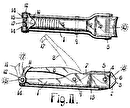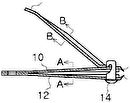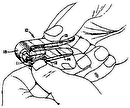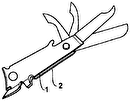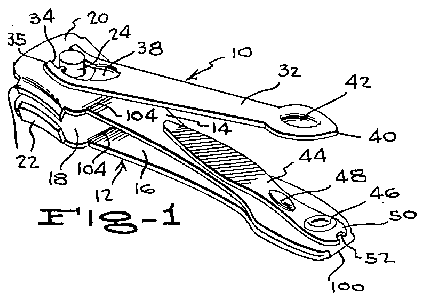
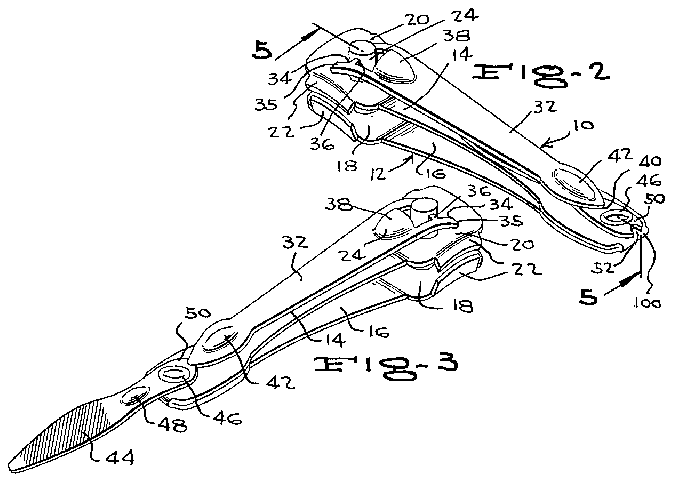
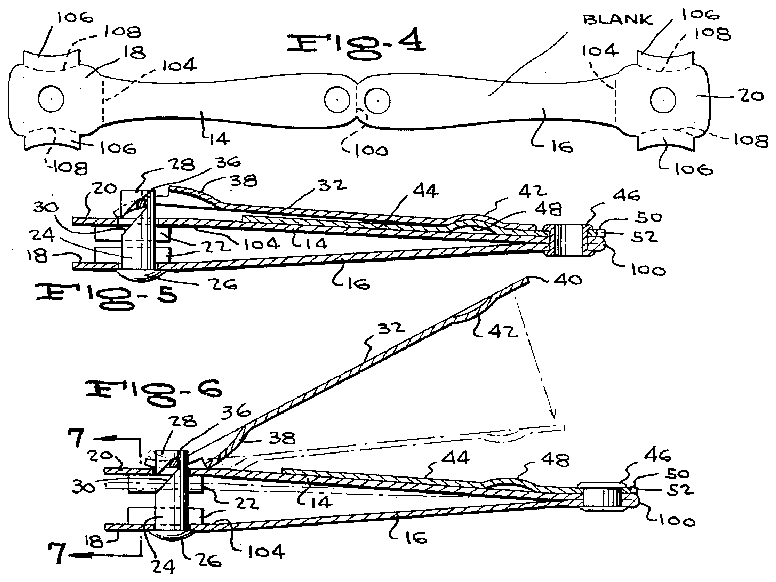

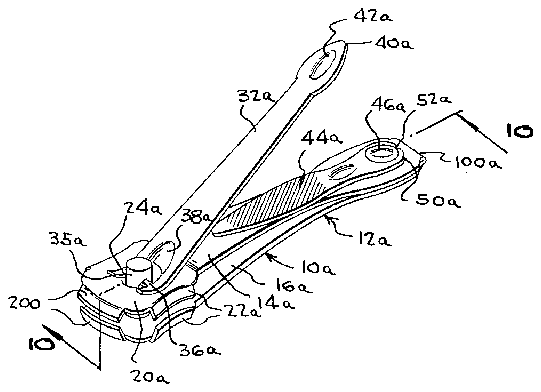
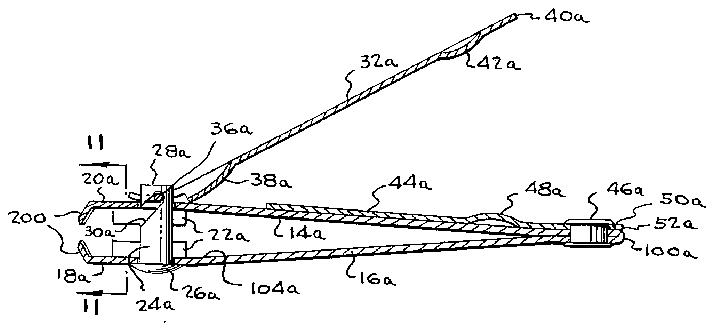
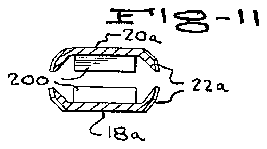
- 4eegure
- 6figure l or
- 12main body
- 14arms
- 16arms
- 18end portions
- 22cutting blades
- 24bolt
- 26enlarged head
- 28end
- 32lever
- 34slot
- 35one end
- 36member
- 38lug
- 40denoted
- 42dished-out portion
- 45rivet
- 46rivet
- 48boss or detent
- 52notch
- 106twardly projecting blade forming members
- 202extensions
- 204extensions
Description
July 3, 1962 s. .1. PLAsKoN MANICUREAPPLIANCES 2 Sheets-Sheet 1 Filed March 17, 1959 July 3, 1962 s. J. PLAsKoN 3,042,047
MANICURE APPLIANCES Filed March 17, 1959 2 Sheets-Sheet 2 BLANK@i 1N V EN TOR.
TTOQ/VEVS United States Patent O 3,042,047 MANICURE APPLIANCES Stephen J. Plaskon, 4 Valley View Ave., Derby, Conn. Filed Mar. 17, 1959, Ser. No. Stltidli 1 Claim. (Cl. 132-755) The present invention is directed to improvements in cutting appliances, and more specifically, to cutting appliances of the type normally referred to as nippers, and finding their greatest utilization as manicure appliances.
Appliances which may be generally described as above are -Well known and have experienced a high degree of acceptance by the public. Generally speaking, such devices consist of a pair of superposed spring arms having connected ends and opposed free ends, a cutting blade formed wholly on each of the opposed free ends, and leverage means for urging the arms towards one another to effect a cutting action. The prior art also provides for the connection of a pivctally mounted, laterally swingable tile member for use in association with the nipper in performing manicure operations.
The concept expressed above is conventional, and the present invention departs from this concept by means of several novel and useful improvements, each of which represents an important advance in the art.
One of the aforesaid improvements resides in the novel formation and positioning of the cutting blades of the appliance described and illustrated herein. As before stated, it has been previously known to provide the appliance with a single pair of generally concave opposed blades positioned transversely of the extremities of the free end-s of the spring arms. In one form of appliance constructed and `assembled within the teachings of the instant invention, a pair of blades are also provided, but are positioned longitudinally of said free ends, at the lateral side edges of the spring arms. Further improvements in the formation of the blades are also provided and appear in more detail below. The change is positioning of the cutting blades, together with a novel angular formation thereof, has been found to result in a nipper of more efficient operation, increased ease of use and, hence, greater appear to 'the users of such appliances. The unique positioning of the cutting blade members results in a nipper which is readily usable in either hand of the user.
Additionally, in a second embodiment of the instant invention, a pair of generally convex, opposed blades are positioned transversely of the extremities of the spring arms, the convex blades being especially adapted for use in the trimming of the toenails.
An additional object and advantage of the present invention is directed to the formation of the spring arms or main bodies of the nippers described herein of single blanks, thereby allowing the body portions thereof to be punched or struck from rsuitable sheet stock with the usual savings in cost of manufacture which result from such production methods.
Another object of this invention resides in the provision of improved means for releasably securing the leverage means of the devices in a non-operative position superimposed over the le member.
Also, the instant invention provides a novel means for engaging the file member in an operative position.
ICC
It is of interest to note that the unique formation of the end portions of the appliances hereinafter disclosed with a plurality of blade elements serve to rigidify the working portions thereof, thus resulting in appliances which are more etficient in operation and more durable in use.
Among the other objects and advantages of improved appliances constructed and assembled as described above, is the fact that such appliances are non-complex in construction and assembly, and inexpensive to manufacture.
Other and further objects and advantages of this invention will become more readily apparent from a consideration of the following specification, Awhen read in conjunction with the annexed drawings, in which:
FIGURE l is a perspective view of one embodiment of the instant invention, the leverage means thereof being shown in its operative position;
FIGURE 2 is a View similar to FIGURE l, but showing the leverage means in its non-operative position;
FIGURE 3 is still another perspective View illustrating the appliance with the file member thereof in its operative location;
FIGURE 4 is a plan view of the blank from Which the main body of the appliance shown in FIGURE 1 is formed;
FIGURE 5 is an enlarged, longitudinal, cross sectional view taken substantially on the line 5--5 of FIGURE 2, looking in the direction of the arrows;
FIGURE 6 is a view similar to FIGURE 5, but illustrating the operation of the appliance, the leverage means and clipper arms being shown in full llines ready for use in performing a cutting operation, and illustrating, in phantom lines, the positioning of the parts during the cutting operation;
FIGURE 7 is a transverse, detail cross sectional view taken on section line 7-7 of FIGURE 6, looking in the direction of the arrows;
FIGURE 8 is a plan view of a blank from which is formed the main body of a second embodiment of the invention;
FIGURE 9 is a perspective view of the second embodiment mentioned above;
FIGURE l0 is a longitudinal cross sectional view taken substantially on the section line `IiP-40 of FIGURE 9, looking in the direction ofthe arrows; and
FIGURE l1 is a transverse, detail cross sectional view taken on section line 11--11 of FIGURE l0, looking in the direction of the arrows.
Proceeding now to a more detailed description of the invention, general reference numeral 10 denotes one embodiment of a cutting appliance constructed and assembled within the broad scope of this invention. The appliance It) comprises a main body portion l2 consisting of superposed upper and lower spring clipper arms 14, 16. As seen in the drawing, the arms 14, 16 are integrally joined at one pair of the adjacent ends thereof and diverge outwardly towards their opposing free ends. The formation of the arms is such that they are constantly biased away from one another, and these members are formed from a single blank of springable material, described in more detail below.
The outer end portions 18, 20, respectively, of the arms 14, 16, are enlarged, and as seen in FIGURES 5,
6, and 7 are bent to a position wherein they are substantially parallel with respect to one another. Each of the end portions 18 and 2li has concave cutting blades 22 formed integrally on the respective, opposed side edges thereof, the blades of the end portion 20 contacting those of the end portion 18 in edge-to-edge relation when the arm 14 is urged toward the arm lr6. It is to be noted that the blades 22 of each end portion are angularly disposed relative to the longitudinal plane of the end portion on which they are formed, in this illustration the angle being generally of 45 degrees.
The end portions 1S and 2t) are each centrally `apertured to receive a swivel bolt 24 having an enlarged head 26 and an opposing end 28. The bolt is notched intermediate its ends at Sil and the notch is seen in the drawing to extend inwardly in the direction of the end 28.
Reference numeral 32 identifies an elongated lever arm having a slot 34 extending longitudinally inwardly from one end 35 thereof. A cross member 36 extends transversely across the slot 34 and is received in the notch 3@ of the bolt 24. As previously stated, the arms i4 and 16 are biased away from one another and, hence, this action of the arms locks the member 36 in the notch $0 and holds the lever arm 32 in place. A lug 38 is formed on the lever 32 immediately adjacent the inner end of slot 34, in longitudinal alignment therewith. The foregoing portions of the description of the `lever 32 and bolt 24 will be seen to provide a means whereby the lever arm, when held in the position illustrated in FIGURE l or 6, may be used to exert force on the spring arm 14 and thereby urge the arms 14 and 16 towards one another to their operative cutting position shown in phantom lines in FIGURE 6.
The end of the lever 32 opposed from the slotted end 3S is denoted 40 in the drawing and, as seen therein, is terminated at a sharp point. A dished-out portion or detent 42 is provided adjacent the end 4l), the purpose of the pointed end 4t) and dished-out portion 42 appearing in more detail below.
An elongated nail le 44 is pivotally connected to the main body 12 adjacent the integrally joined end of the arms 14, i6 by means of a rivet 46, the rivet 45 having a bore passing therethrough by means of which the appliarlce 12 may be strung on a key chain or the like. The iile 44 is provided with a boss or detent 48 which is formed to be engageable in the dished-out portion 42 of the lever 32 to ilockingly hold said lever and said file in the inoperative or nonuse position of FIGURES 2 and 5.
Additionally, it is of importance to note that the end 5d of the file adjacent the rivet 46 is somewhat extended therebeyond and has a V-shaped notch 52 formed therein. As seen in FIGURE 3, the pointed end of the lever 32 is engageable in the notch 52 when the lever is in the non-use position thereof and the iile is in its extended position, and by this arrangement the le is locked in its normal use position.
The clipping operation of the appliance 16 is best illustrated in FIGURE 6 wherein it is seen that the lever 32 is inverted to the position of FIGURE l, that is, with the lug 38 bearing directly against the outer surface of the spring arm i4. As stated in the objects of invention, the device is equally adaptable to the trimming of the finger nails of either hand by reason of the unique positioning and formation of the cutting blades 22. The positioning of said blades at the lateral edges of the appliance, coupled with the fact that the blades are disposed at such angle as to have their cutting edges project outwardly from the main body, thereby enables the user to grasp the appliance in either hand, and to easily and accurately trim the nails of his other hand.
In FIGURE 4, the blank from 'which the main body 12 `of the first embodiment it) of the invention is formed is shown in plan view. The blank will b e seen to be elongated and to be formed preferably of a springable,
metallic stock. A central fold line ltitl is provided intermediate the ends of the blank whereby the blank is folded over or reverted to form the spring arms 14, 16. The end portions i8, 2i) are formed by bending the arms 14 and 16 about the fold lines N2 and 1164, respectively, adjacent to but spaced from each of the distal ends of the blank. Additionally, a pair of laterally outwardly projecting blade forming members 106 yare provided on the blank on the opposed sides of the portions thereof forming `the end portions 18, 2li. Spaced inwardly from the outer ends of said `blade forming members are curvilinear fold lines 1li@ about which the blade forming members ill are folded for forming the cutting blades 22. The blank is also apertured at suitable locations to provide for the insertion of the rivet 46 and the bolt 24.
FIGURES S through l1, inclusive, are illustrative of a second embodiment litio of this invention wherein the various structural members which are substantially the same as those lshown and described with regard to the embodiment l@ are denoted by a similar reference character having the letter a added thereto. The second embodiment itin diiiers from the iirst embodiment 10, and from the prior art, in the formation of a pair of end blade forming members 2e@ positioned transversely of the outer extremities of the end portions 18a, 20a. As Seen in the drawings, the blade members 200 are convex in conguration and are angularly inclined outwardly with respect to the aforesaid end portions 18a, 2da, and are yadapted to be moved into edge-to-edge contact in order to perform their cutting operation.
As stated in the objects of invention, the convex formation of the blades 20h, coupled with the angular inclination thereof relative to the end portions 18a, 20a, renders them especially adaptable `to the trimming of toenails. Furthermore, the rigidifying effect of the formation of a total of three blades on each end portion further improves the operation and durability of the appliance.
in FIGURE 8, the blank for the formation of the main body 12a of the appliance 10a is seen to be substantially the s ne `as the blank of EEGURE 4. However, the former diners in that it has extensions 202, 204 which are provided for the formation of the blades 200, curvilinear fold lines 2&5, 26S, respectively, being provided for this purpose.
Having described and illustrated two embodiments of this invention in somewhat complete detail, it is to be understood that this invention is not to be limited in scope by the aforesaid descriptions, and that the invention is to be deiined in Ithe appended claim.
What is claimed is:
A manicure appliance comprising a main body portion including a pair of elongated substantially superimposed spring arms, rivet means securing said arms to one another and passing therethrough adjacent one of their pairs of ends with the other ends of the arms being normally biased -away from one another, said arms at their outer ends having substantially fla-t end portions normally biased apart, said end portions being bent to be substantially parallel to one another with each having an end edge and lateral side edges, cutting blades on the lateral side edges of the respective end portions adjacent to but spaced inwardly from said end edges thereof, a convex cutting blade on the end edge of each of said end portions, said convex blades -being moved into edge-to-edge contact simultaneously with the movement of the rstnamed blades into a contacting relationship, a bolt extending transversely through said last-named ends and projecting outwardly from said arms, said bolt having a notch, a lever arm pivotally mounted at its proximal end in said notch of said bolt, said lever arm having a pointed V-shaped distal end and being arranged to be llocated adjacent one of said spring arms in an inoperative position, the pointed end being adjacent to but spaced inwardly from said rivet when said lever arm is in said inoperative position, a file member connected for lateral rotational movement around said rivet means as an axis, said file member having a ile carrying portion extending outwardly from one side of the rivet and a short extension projecting from the opposite side thereof, said short extension `having a V-shaped notch formed therein and being of a length such that it receives the pointed end of said lever arm when the file is pivoted to a position to form an extension of said main body portion whereby the le member is effectively maintained in said extended position.
References Cited in the file of this patent UNITED STATES PATENTS Sickles Aug. 23, 1904 Blader Aug. 16, 1910 Campbell Sept. 27, 1921 Dalmas July 19, 1932 Bassett Mar. 20, 1956 Guardno June 16, 1959

